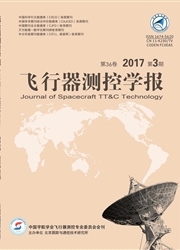

 中文摘要:
中文摘要:
“嫦娥三号”将在月球放置着陆器,实现月面软着陆,因此,需要对着陆器进行精确定位.本文简述了月球着陆器的统计定位方法与协方差分析理论,分析了影响统计定位精度的主要误差源.基于现有测控条件,从跟踪弧段和测量数据组合2个方面,对“嫦娥三号”着陆器的定位精度进行了分析.针对短弧条件下单站测距数据定位不稳键的问题,提出了结合月面高程约束的定位方法.协方差分析结果表明:高程数据的使用可以实现单站30 min测距优于1 km的定位精度;当观测数据累积至3d时,单站测量与VLBI(Very Long Baseline Interferometry,甚长基线干涉测量)的不同组合可以实现同等量级、优于百m的定位精度;测量系统差是制约定位精度的主要因素,完全标校测量的系统偏差则能实现10 m左右的定位精度.
 英文摘要:
英文摘要:
A lander shall be placed on the moon in CE-3 (Chang'e-3) lunar exploration program to fulfill soft-land- ing. Therefore, accurate determination of the position of the moon lander is required. Following description of sta- tistical positioning method and covariance analysis theory for moon landers, the major error sources influencing the accuracy of statistical positioning are analyzed. Based upon the present tracking conditions, the positioning aceuraey of Chang'e-3 is analyzed in terms of tracking arc and tracking data combination. A method using lunar elevation model is proposed to enhance the positioning integrity of short-arc ranging data of a single station. It is demonstrated that the positioning accuracy with 30 rain ranging from a single station is increased to 1 km after use of lunar eleva- tion data. As the tracking data reaches 3 days and with combinations of single-station measurement and VLBI (Very Long Baseline Interferometry), a solution better than 100 m can be got. The systematic error of tracking data is the main factor that limits positioning accuracy. Once the systematic error is minimized through calibration and tests, a better solution of 10 m accuracy can be achieved.
 同期刊论文项目
同期刊论文项目
 同项目期刊论文
同项目期刊论文
 期刊信息
期刊信息
